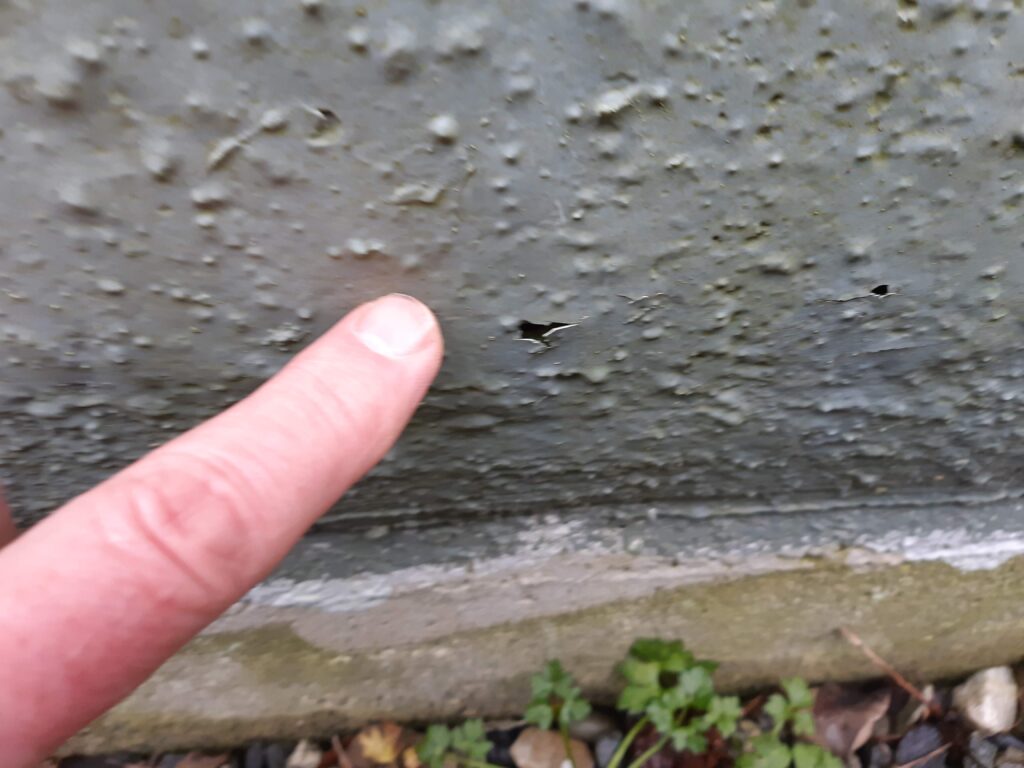Photo: Stucco blister that when pressed, squeazed out water. Never a good sign to have water behind an exterior surface.
Abstract: West Vancouver Home Inspector notes on a building envelope that is not performing as required, indications and consequences.
Building Envelope Defined
Think of the building envelope as a raincoat for the house. Its purpose is to shed water and keep the structure dry inside. When the raincoat fails, then the person is wet and miserable. In the same way, if a building envelope fails then moisture enters the inner spaces.
Unfortunately, in most cases, a distressed building envelope does not have an immediate impact so that the home owner would notice. Usually over a period of years, this moisture ingress quietly develops into something nasty… impacting exterior structures, interior finishes and indoor air qualiity.
Exterior Warning Signs
For the purposes of this blog, we will restrict the discussion to vertical surfaces. A discussion of roofing issues will be te focus of another post.
If we walk around the exterior of a house, there are numerous indicators that the building envelope is not performing, that is, leaking.
- Stucco – Cracks and blisters will be visible. Water stains will be visible on a vertical wall. In some cases, there will be a discoloration of the surface.
- Wood Siding – Rot is the predominant red flag that water penetration has done a number on the material. In addtion, paint will have major bubbles. In some cases, behind the paint there is wood rot too.
- Soffit – This is the underside of roof overhang. If there is a problem with the roofing at the edge, then not all the rainwater is captured and drained away by the gutter and downspout. For example, the gutter downspout may be clogged, resulting in a water dam. Water then travels under the roof and will penetrate through the soffit. A wood soffit will rot. A metal or plastic soffit will have dark stains.
- Window Trim – So many windows are installed with inadequate trim so that rainwater is able to penetrate behind the trim and into the wall. There is a type of flashing that is used along the top edge of the window, sometimes referred to as a drip edge, that in many home reno projects is not installed, to the detriment of the house.
- Wall Penetrations – Dryer exhaust vents, kitchen exhausts fans, bathroom vents, air supply ducts, AC tubing, natural gas lines… are all examples of penetrations made into walls that need to be sealed with the correct product and capped with the specialized exterior hood, where necessary. Shortcuts and incomplete installations result in penetrations that let in water in addition to their intended use.
- Wrong Angle – Whenever there is trim or a flat surface, there should always be a slight tilt away from the house. Any angle towawrds the hosue only encourages water to flow into the wall.
Interior Damage
By the time water has penetratated through a wall to be noticeable enough to be visible, hidden damage has already occured. Look for these red flags.
- water stains on walls or ceilings
- swollen baseboards
- puffy, crumbly drywall
- rusty nail or screw heads appearing through paint
Poor Indoor Air Quality
If conditions are right (temperature, moisture content, food source), then organic growth or mold happens. When it appears on an interior surface, it manifests as grey-black specs and splatters on a wall surface. If the infestation is severe, it may give off a pungent smell.
Our concern here is real and needs immediate attention. Indoor air quality affects everyone’s wellness, especially that of children.
Now What?
Job #1 is to stop the source of the leaks. Easily said, but it may be difficult to locate and costly to repair. There are no shortcuts.
In some cases, home owners may choose to ignore the issue and just live with it. Yes it’s an option but remember that the house follows the rules of entropy… the structure and finishes will continue to deteriorate.
Finally where indoor air quality is important, an environmental testing firm should be contacted to sample both the surfaces and air for mold. A remediation plan can then be implemented, from just surface cleaning to removal of compromised components.

